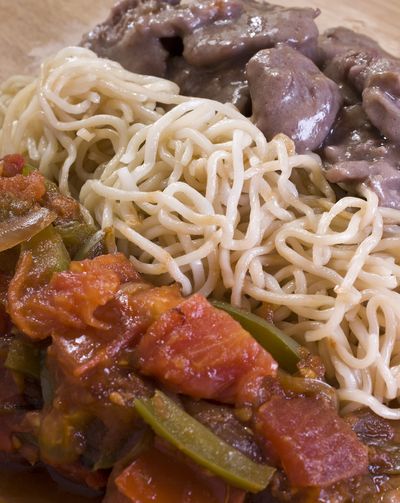Eat right for Chinese New Year

SAN FRANCISCO – Have your luck and eat it, too.
That’s the philosophy behind traditional Chinese New Year’s dishes, which are loaded with symbolic meaning auguring prosperity for the coming year.
Want to live long? Eat long noodles – just be sure not to cut them.
Need a bit more in the bank? Serve fish, the Chinese name for which sounds like the word for surplus.
And don’t forget dumplings, which also symbolize prosperity and are traditionally eaten late on the eve of the New Year.
The Year of the Rabbit starts with the big “reunion dinner” on New Year’s Eve – Feb. 2 this year – a meal reserved for family.
Carolyn Jung, a San Francisco Bay food writer who blogs at www.foodgal.com, remembers sitting at the table as the youngest of her family, and only girl, helping her mom fold dumplings by hand and “waiting eagerly for her to pan fry them or boil them so that we could dig in.”
Chinese New Year is celebrated in many parts of the world that have sizable populations of Chinese immigrants, and other Asian cultures have similar celebrations. With so many people involved, the customs aren’t uniform, though the hope for a prosperous new year is a constant.
The festival lasts 15 days, with some days set aside for visiting and other rituals. It wraps up with a Lantern Festival on the final night.
For Patricia Tanumihardja, who grew up in Singapore and is of Chinese and Indonesian descent, the holiday means eating pineapple tarts, which generally call for a luscious pineapple jam stuffed into flaky pastry.
“Every year that was the one thing I wanted to eat,” says Tanumihardja, author of “The Asian Grandmothers Cookbook.”
This is the time when luxury ingredients such as shrimp or abalone shine and fish is served whole to symbolize plenty. Serving whole poultry also is a sign of family unity and Tanumihardja sometimes makes a whole braised duck.
In Singapore, a raw fish salad is served in restaurants with the ingredients kept separate on a large plate or tray. Before they eat, diners stand and toss the salad as high as they can saying auspicious words like “Every year we’ll have prosperity.”
As a kid, Jung saw Chinese New Year as mostly about the food – and the red envelopes filled with crisp dollar bills that are handed out to children. She spent the money and kept the brightly decorated envelopes, keeping them neatly stowed away in a drawer.
As she grew up, the holiday became more about family. These days she often makes her mom’s tomato beef chow mein, a blend of East and West cooking styles typical in Chinese-American kitchens.
“I remember so many times peeking over her shoulder as she crisped up the noodles in the pan,” says Jung.
Jung’s mother passed away some years ago, and a lot of her recipes are gone, “but this was one that I did get her to write down.”
The recipe isn’t strictly orthodox New Year’s fare, but the noodles symbolize the traditional wish for long life.
And making a dish in memory of her mother fits Jung’s grown-up perspective on the holiday.
“As I get older and the family gets larger with significant others and kids and people moving away, it’s one of the holidays where we really make an effort to gather and to see each other and catch up.”
Tomato Beef Chow Mein
Start to finish: 1 hour 15 minutes (45 minutes active)
Servings: 4
For the meat:
1 teaspoon sesame oil
1 teaspoon dark soy sauce
1/4 teaspoon baking soda
1 teaspoon cornstarch
½ pound flank steak, thinly sliced against the grain
For the noodles:
1 pound fresh Chinese egg noodles
2 tablespoons sesame oil
2 tablespoons dark soy sauce
For the sauce:
4 tablespoons vegetable or canola oil, divided
1 yellow onion, thinly sliced
2 ribs celery, diagonally sliced
½ green bell pepper, sliced
4 large tomatoes, cored and cut into large chunks
14½-ounce can stewed tomatoes
1 teaspoon dark soy sauce
1 teaspoon vinegar or lemon juice
1 tablespoon sugar
1 teaspoon ground ginger
2 tablespoons cornstarch, mixed with ½ cup cold water until dissolved
To marinate the meat, in a medium bowl mix together the sesame oil, soy sauce, baking soda and cornstarch. Add the steak and turn the pieces to coat evenly. Refrigerate for at least 30 minutes.
Once the steak has marinated, prepare the noodles. Bring a large pot of water to a boil. Add the noodles and cook for 1 minute. Drain the noodles, then rinse them under cold water, then drain again. Transfer the noodles to a large bowl. Add the sesame oil and soy sauce, then toss well.
Heat two 12-inch nonstick skillets briefly over medium. Add 1 tablespoon of the vegetable or canola oil to each. When the oil is hot, add half of the noodles to each skillet. Cook, stirring often, until the noodles are crispy and lightly browned. Cover the pans and set aside.
Heat a large wok or nonstick skillet over high. Add 1 tablespoon of the oil. When the oil is hot, add the beef and stir-fry until browned, about 2 to 3 minutes. Transfer the steak to a bowl, cover and set aside.
Add the remaining tablespoon of oil to the wok. Reduce heat to medium-high, then add the onion, celery and bell pepper. Saute for several minutes, then add the fresh tomatoes, stewed tomatoes, soy sauce, vinegar, sugar and ginger. Bring to a boil.
Slowly stir in the cornstarch mixture, then continue cooking until the sauce thickens. Add the beef, then stir in the noodles.